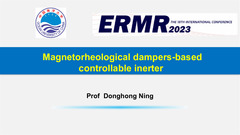Vibration control of semi-active seat suspension with magnetorheological damper-based controllable inerter
ID:31
Submission ID:27 View Protection:ATTENDEE
Updated Time:2023-03-14 09:23:36 Hits:883
Oral Presentation
Abstract
Seat suspensions have been widely applied in applications to reduce the risk of driver injury and improve ride improvement. This paper proposes a new semi-active seat suspension with a two-magnetorheological (MR) damper-based controllable inerter. The proposed inerter includes a flywheel and a new controllable mechanical motion rectifier (CMMR) with two MR dampers. The device can convert the reciprocating vibration into the rotation of the flywheel, and the flywheel can release the stored energy to generate controllable force for vibration reduction. Based on the dynamics model of the controllable inerter, we design a force-tracking controller for accurate control of the output force. Then, a semi-active controller for the seat suspension is designed for vibration control. First, the sliding mode control calculates the desired control force. Then a semi-active control strategy is proposed to control the two MR dampers to generate proper forces close to the desired force. Finally, the vibration control performance of the seat suspension under harmonic, bump, and random excitation is numerically simulated, and the magnitude of the frequency-weighted acceleration root mean square (RMS) and power vibration dose value (VDV) of the suspension are calculated according to the international standard ISO 2631. The simulation results show that the suspension has better damping performance than the traditional passive seat and semi-active variable damping seat.
Keywords
MR,semi-active seat suspension,Vibration control
Submission Author
Jing Cao
Donghong Ning
Ocean University of China; China; Qingdao
帅帅 孙
中国科学技术大学
Guijie Liu
中国海洋大学
Haiping Du
University of Wollongong


Comment submit